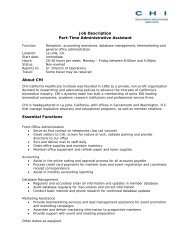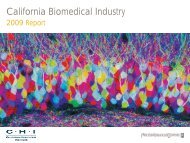California Biomedical Industry - California Healthcare Institute
California Biomedical Industry - California Healthcare Institute
California Biomedical Industry - California Healthcare Institute
Create successful ePaper yourself
Turn your PDF publications into a flip-book with our unique Google optimized e-Paper software.
Researcher profileRonald M. Evans, PhD, is a professorand March of Dimes Chair inMolecular and Developmental Biologyin the Gene Expression Laboratory atthe Salk <strong>Institute</strong>.How did you become interestedin diabetes and other metabolicdisorders?My interest has been in energyhomeostasis — how food is acquired,stored and burned. The underlyingproblem is that we are in the midst ofa pandemic of inactivity marked byan absence of movement or exercise.In our national state of sedentarybehavior it is a challenge for mostpeople to get the exercise they need.The result is increased weight gainand insulin resistance, which increaseobesity, diabetes, heart disease andhypertension.We began looking at nucleic receptors— a class of genetic switches thatcontrol transcription of the genesthat control the energy-burningnetwork of processes. That network isusually triggered by exercise, but wehypothesized that small molecules maygenerate the network to trick the musclecell into thinking it is being exercised.Genomic exercise, if you will.What are the fundamentalquestions in researching“genomic exercise.”We are trying to understand whatmuscle activity triggers at a metaboliclevel….The end chemical product ofexercise is the AMP kinase (AMPK),which is the master energy switch thatstarts to suck more sugars and fatsfrom blood into the muscle. In exercise,the kinase leaps into the nucleus [ofthe muscle cell] and activates the genenetwork, triggering a genetic cascade. Inthis way, AMPK converts stored energyinto chemical energy. The first challengewas to determine whether the genenetwork differentiates between physicaland nuclear effect. That is, could a smallmolecule trigger the same gene networkto behave in the same way as it reacts tophysical exercise?What have you found so far,and what might it mean forhuman applications?We have tested a few smallmolecules in sedentary mice for aperiod of one month. We showeddramatically improved performance —improvements that were about the sameas daily exercise. The treated mice hadlower blood sugars and lipids, improvedvascular performance and improvedmitochondria numbers.I think the work clearly demonstratesthat in mice, it is possible to developdrugs that have the capacity to enhancemuscle performance with out actuallyexercising. That is a major advance.It also identifies two key drug targetsfor which the next generation of moreeffective muscle-enhancing drugs canbe produced for people. In fact, thedrugs that we used have already beenin people. So now I would say it is goingto take a large pharmaceutical companyto develop the right type of program inmuscle biology.The challenge in bringing this forwardis getting the FDA to agree that frailtyand obesity can be treated with muscleenhancingdrugs. You have to curedisease to get a drug approved. Wethink we can make people a lot morehealthy. But making people healthy isnot an FDA approval end point. Weneed to educate the public and themedical community to move the FDAtoward accepting the benefits that canbe achieved by this kind of program.In your career so far, whathas been the discovery thathas fascinated you most?The growing realization that so muchof body physiology, endocrinology andbehavior is really about the controlof gene networks. My initial interestsin the early ‘80s were to study themechanics and logic of how the genomeis controlled. Our interests in cloninghormone receptors ultimately providedus with a key to unlock the secrets ofthe genome. In the beginning, science isabout overcoming technical challenges,which in the end open new avenues ofapproaching complex problems.What keeps you passionateabout science?Science to me is like the ultimate chessgame where the opponent is MotherNature. You’re trying to win secrets in anever-ending duel. There’s nothing thatis more thrilling than pitting yourselfagainst problems that are not yet solved.On working at The Salk <strong>Institute</strong>:The level of work and standards are veryhigh, and if you are not on the cuttingedge, you are not going to survive forlong. It’s not for everyone, but it is veryexciting and attractive to me. The Salkand La Jolla is a privileged place to be.We have a unique mix in the researchenvironment, with Salk, Scrippsand Sanford-Burnham, and a highconcentration of biotechnologyand pharmaceutical companies in avery tight zone.84 | <strong>California</strong> <strong>Biomedical</strong> <strong>Industry</strong> 2011 Report






